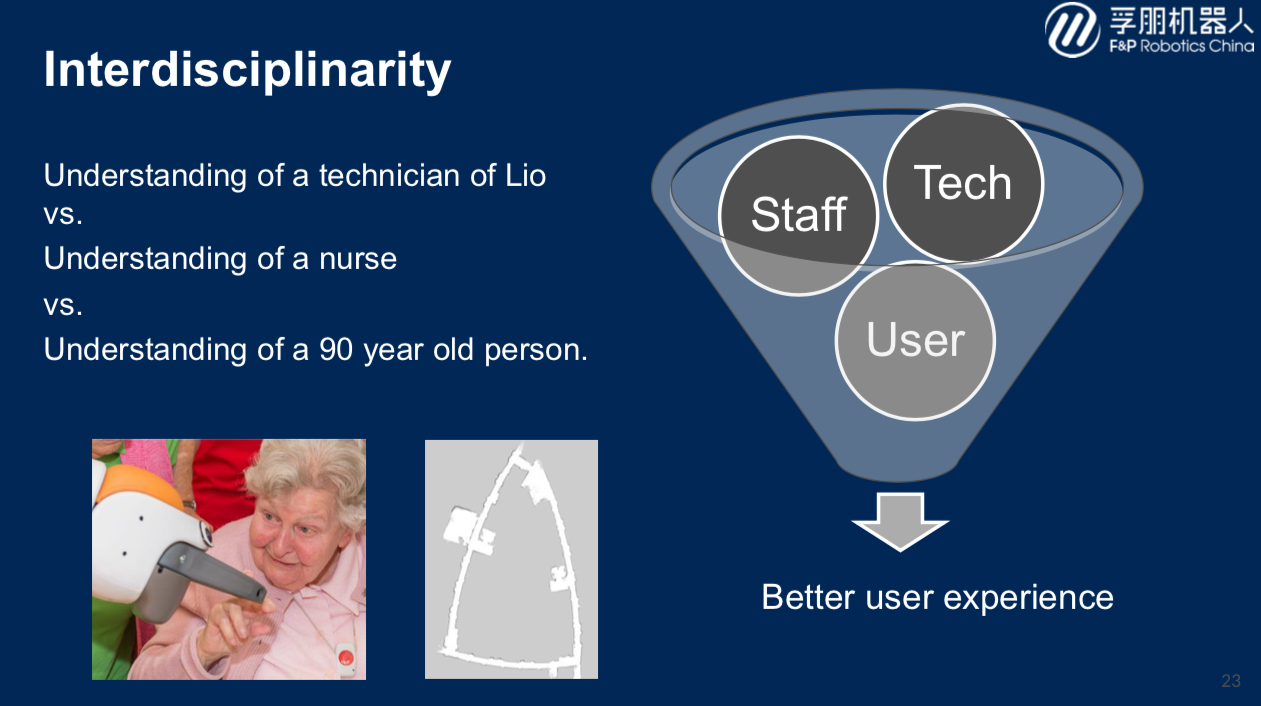By Aijing Cao, Junior Project Manager - Art-Science
According to China’s latest national population census, the size of the Chinese elderly population has grown prominently and the birth rate continues to fall. In the meantime, the mounting shortage of caregivers for the aging populations has put the elderly care industry in a situation with enormous demand and unprecedented potential as well.
Therefore, the 28th Café des Sciences is pleased to invite two speakers Michael Früh, CEO of F&P Robotics, an innovative robotics company headquartered in Glattbrugg, Switzerland and with a subsidiary in China, and Monica Zhang, Director of the Business Development of F&P Robotics’s APAC region, to share their expertise and insights about the robotics industry in elderly care, current developments and user cases from Switzerland to China.
First, Michael reaffirmed the indisputable elderly wave in certain countries and the solution of using robots to ease the challenge of shrinking labor force. The market potential in Europe is estimated to be more than 250,000 robots (1 robot per 20 nursing beds). As one of the three main product units of F&P, Lio, the mobile robotic assistant can help increase the quality of life and independence for the elderly while relieving care personnel from routine tasks, reducing infections, and improving health with an outstanding maximum of 16 working hours per day. Michael elaborated the user cases of Lio at care institutions in Switzerland and Germany to further present the versatility and intelligence of Lio with a list of activities, such as activation, delivery, disinfection, reminding, interaction, entertainment, and physical support at home.
According to Michael, relying on the support of the AI lab of the University of Zurich and ETH Zurich, F&P Robotics can be considered as the pioneer of this niche market, which aims to blend smart and safe robots into human’s daily life with the utilization of Robotic arm technology, Applied AI and self-developed own Robot Operating System, together with the specialization on safety and personality for an improved user experience.
Michael also pointed out the importance of market knowledge to achieve constant optimization. Their efforts in this regard include experiencing unique projects in healthcare, hiring in-house interdisciplinary talents in neurobiology, medicine, AI, psychology, and health economics, co-authoring books on healthcare robotics, and establishing and maintaining connections to top Swiss institutions in the healthcare industry. In addition, F&P has been trying to increase robot technology acceptance through improvements in their function, social capability, appearance and autonomy level, and local culture adaption.
In the end, Michael summarized critical success factors for F&P to have grown from a startup to an SME: product development to cater customers’ needs, providing helpful services, education and training, involving various stakeholders from the beginning, taking concerns seriously, networking to facilitate the first contact, offering USPs based on needs, managing production and logistics and securing sufficient capital.
Following Michael’s overview in Europe, Monica gave an analysis of the care industry in China, challenges of the care robots in the local market and potential solutions. China’s aging population is foreseen to grow up to 27.9% of the entire Chinese population by 2050. The smart care industry size has also soared from CNY1.41 billion to CNY3.76 billion in 2020, almost taking up 42.9% of the global care industry. At the current phase, China’s elderly care mode has formed a “9073 ” structure; namely, 90% of the elderly would live at home and be supported by families and social forces, 7% of the older people are taken care by the communities, and 3% of the aging population live in care institutions. The lack of skilled caregivers and the digitization in the healthcare industry accelerated by the pandemic, have been driving the demand for care robots.
Furthermore, Monica touched upon the existing challenges in introducing care robots into the China market. First, the long-rooted mentality of saving money has made the Chinese elderly groups less willing to pay for care robots even though they have the capability. Second, data collection and data security need more clear and explicit guidance. Despite the strong support from the government policy, technical feasibility, interdisciplinary cooperation, low expectation, and fear against the care robots are still impeding the acceptance of the care robot. As Monica stated, China is still in the stage of market and consumer education, but she is positve about the market prospect in China.
During the Q&A session, both onsite and online audiences were curious about limitations of current robot technologies and the potential of care robots. Due to time constraints, we could only take a limited number of questions. If you have further questions for our speakers regarding robot technology in elderly care, please email us at artscience@swissnexchina.org. We will try our best to forward them to the speakers.
Click here to watch the recording of the event.




